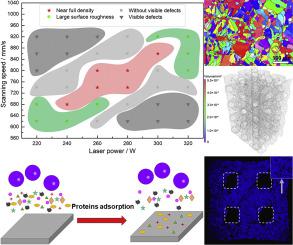Biomaterials Advances ( IF 5.5 ) Pub Date : 2020-03-26 , DOI: 10.1016/j.msec.2020.110903 J.P. Luo , Y.J. Huang , J.Y. Xu , J.F. Sun , M.S. Dargusch , C.H. Hou , L. Ren , R.Z. Wang , T. Ebel , M. Yan

|
Some β-Ti alloys, such as Ti-Nb-Ta-Zr (TNTZ) alloys, exhibit a low Young's modulus and excellent biocompatibility. These alloys are promising new generation biomedical implant materials. Selective laser melting (SLM) can further enable customer-specific manufacturing of β-Ti alloys to satisfy the ever-increasing need for enhanced biomedical products. In this study, we quantitatively determined the relationships between porosity, yield strength, and Young's modulus of SLM-prepared TNTZ lattices. The study constitutes a critical step toward understanding the behavior of the lattice and eventually enables tuning the Young's modulus to match that of human bones. Fatigue properties were also investigated on as-printed lattices in terms of the stress limit. The biocompatibility study included a routine evaluation of the relative cell growth rate and a proteomics analysis using a common mouse fibroblast cell line, L929. The results indicated that the as-printed TNTZ samples exhibited evidence of protein proliferation of the L929 cells, particularly P06733, and that those proteins are responsible for biological processes and molecular functions. They in turn may have promoted cell regeneration, cell motility, and protein binding, which at least partially explains the good biocompatibility of the as-printed TNTZ at the protein level. The study highlights the promising applications of additively manufactured TNTZ as a bone-replacing material from mechanical and biocompatibility perspectives.
中文翻译:

具有可调杨氏模量的增材制造的生物医学Ti-Nb-Ta-Zr晶格:力学性能,生物相容性和蛋白质组学分析
一些β-Ti合金,例如Ti-Nb-Ta-Zr(TNTZ)合金,具有低的杨氏模量和出色的生物相容性。这些合金是有前途的新一代生物医学植入材料。选择性激光熔化(SLM)可以进一步实现客户定制的β-Ti合金制造,以满足对增强型生物医学产品不断增长的需求。在这项研究中,我们定量确定了SLM制备的TNTZ晶格的孔隙率,屈服强度和杨氏模量之间的关系。该研究是理解晶格行为的关键步骤,并最终使杨氏模量得以调整以匹配人体骨骼。还根据应力极限对印刷后的晶格进行了疲劳性能研究。生物相容性研究包括常规评估相对细胞生长速率和使用常见的小鼠成纤维细胞系L929进行蛋白质组学分析。结果表明,印制的TNTZ样品显示L929细胞(特别是P06733)的蛋白质增殖的证据,并且这些蛋白质负责生物学过程和分子功能。反过来,它们可能促进了细胞再生,细胞运动和蛋白质结合,这至少部分解释了印制的TNTZ在蛋白质水平上的良好生物相容性。该研究从机械和生物相容性的角度突出了增材制造的TNTZ作为骨替代材料的有前途的应用。结果表明,印制的TNTZ样品显示L929细胞(特别是P06733)的蛋白质增殖的证据,并且这些蛋白质负责生物学过程和分子功能。反过来,它们可能促进了细胞再生,细胞运动和蛋白质结合,这至少部分解释了印制的TNTZ在蛋白质水平上的良好生物相容性。该研究从机械和生物相容性的角度突出了增材制造的TNTZ作为骨替代材料的有前途的应用。结果表明,印制的TNTZ样品显示L929细胞(特别是P06733)的蛋白质增殖的证据,并且这些蛋白质负责生物学过程和分子功能。反过来,它们可能促进了细胞再生,细胞运动和蛋白质结合,这至少部分解释了印制的TNTZ在蛋白质水平上的良好生物相容性。该研究从机械和生物相容性的角度突出了增材制造的TNTZ作为骨替代材料的前景广阔的应用。这至少部分解释了印制的TNTZ在蛋白质水平上的良好生物相容性。该研究从机械和生物相容性的角度突出了增材制造的TNTZ作为骨替代材料的有前途的应用。这至少部分解释了在蛋白质水平上印刷的TNTZ的良好生物相容性。该研究从机械和生物相容性的角度突出了增材制造的TNTZ作为骨替代材料的有前途的应用。









































 京公网安备 11010802027423号
京公网安备 11010802027423号